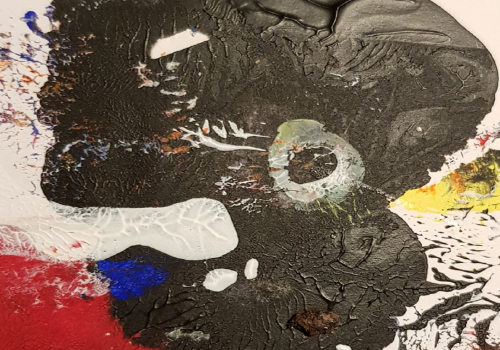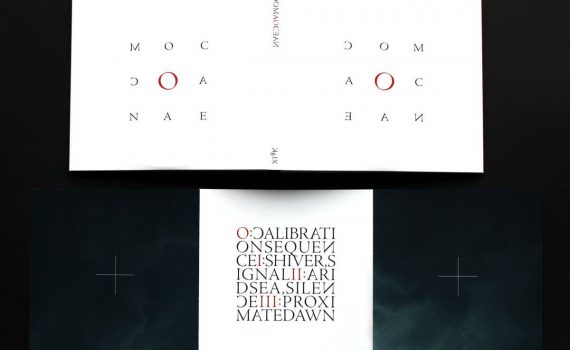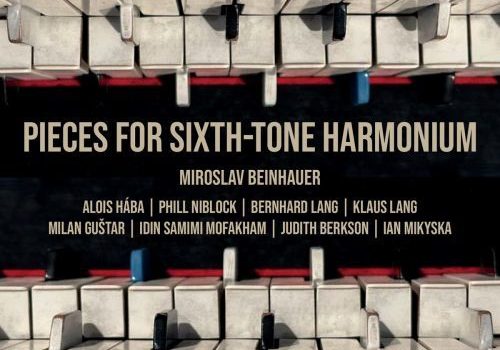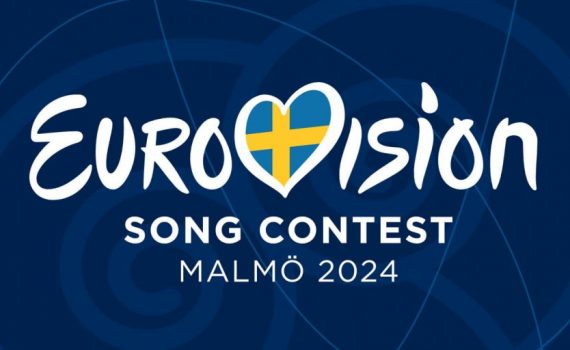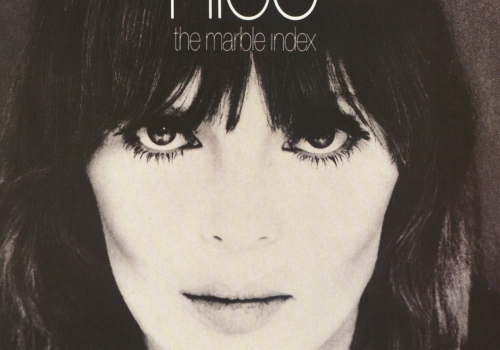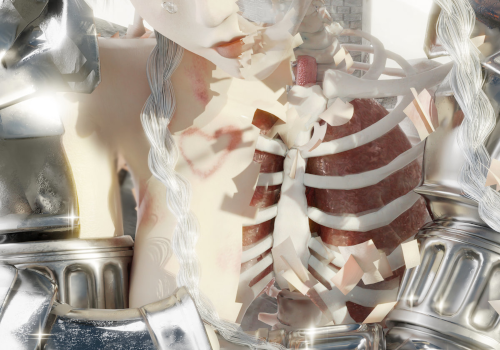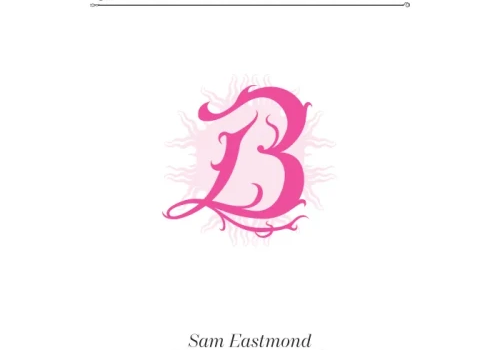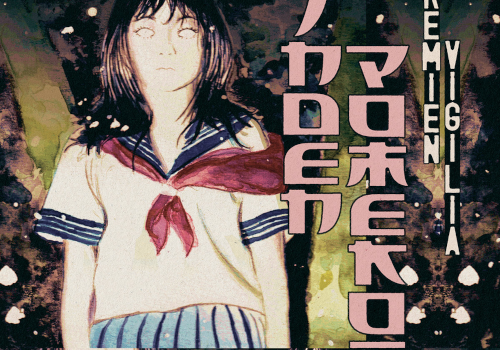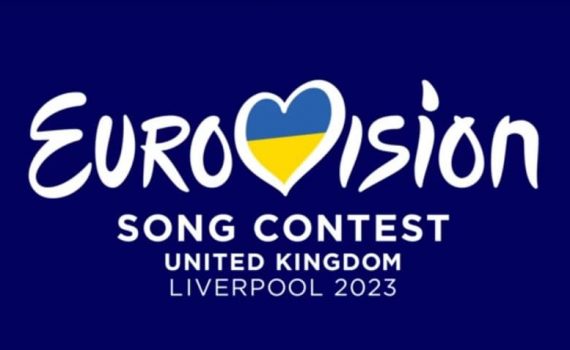For my money, my problem with prog is that it misses out on colour and variation -- it's all well and good having twenty-minute songs, but if it's effectively five songs shunted together, or one idea drilled into the ground, it's just pish. Not the case with ANTA -- they do move around a lot, but keep harmonic and melodic continuity; there's plenty of time signature-hopping, but it's complementary rather than discontinuous (which very quickly sounds like smart-arsery in my book).
Kev Nickells
And speaking of bright side, I'm not sure this record has one; it's like a sticky crawl through some hypnogogic desert-cum-abandoned-shipyard. It's not lacking in wit, or at least the uncanny oddness of a kid laughing, but it's consistently weird.
...the artwork's text resembles (at a squint) something like a boustrophedon, but there's a strong sense that the label Keraunograph have spent a lot of time thinking about font-weights, spacing and those typographical niceties. What I'm saying is that where the sleeve actively resists identification by typical modes, there's emphasis placed elsewhere that makes it identifiable, if not 'legible'.
...the sixth tone harmonium is a harmonium with three registers that's tuned very differently to your average twelve-tone equal temperament piano. The sound here is "very microtoney". The daddy of this is Alois Hába (1893-1973), a Czech composer who saw greater harmonic possibilities from expanding the reach of Western tonality, rather than the increased compositional complexity of twelve tone (as created by Arnold Schönberg).
Folio is a new thing that Greyfade are doing; on top of their gorgeously designed and delivered records,they're putting together books that complement and wrap the recordings in a load more context. We get a record, Three Cellos By Kenneth Kirschner and a book alongside it. The introduction to the book sets out their store in this regard -- a record is more than just the given digital artefact, it's an accumulation of a load of work. I don't think the idea is to take away the recording in its place as the primary 'form' of a work, but there's certainly a commitment to furnishing the recording with a bunch of context.
The annual tradition of Kev Nickells giving the entries to the Eurovision Song Contest the benefit of his particular opinions has come to Freq once more. Strap in for his guide to the ups, highs, downs and disappointments of the musical dream of the year to some, a nightmare of cheesetastic proportions for others. Albania | Besa “Titan” Is it good? It’s kind of OK, it does a […]
I think of all the Velvet Underground effluvia this is the record I come back to most. I still massively rate Lou Reed as a songwriter but Nico is sheer vibes, like a cliff-face. From one angle she's massively unaffected -- the thin voice, that querulous vibrato. The proper folk singer approach of singing the notes largely undecorated. Nothing clever in her singing.
In Real Life One of the more fun things about musicians in their twenties, probably, is that they have admirable disregard for the norms of music because, well, why would you. This is listed as an album and is just north of twenty-five minutes long. But it is, of course, about what you can pack in, not how long you take. And I doubt most people making ‘albums’ […]
One of the major differences between the live and the home experience is that I'm now at an age where I'm not inclined to wind up the neighbours with excessive volume. So the home experience misses something of the blur of the shape of the room from the exceptional volume of the live version. I imagine part of the live effect is precisely that the tones find different refractions from the contours of a given room, generating cross tones and various Tartini effects.
What's being reviewed here is two things: a book, Subcontinental Synthesis: Electronic Music at the National Institute of Design, India 1969–1972 , edited by Paul Purgas, and a record, The NID Tapes - Electronic Music From India 1969-72. The NID of the LP's title refers to the National Institute of Design, a home for electronic music within India of the late 1960s. The book is a more expansive look at electronic music in that era, and one is a taster for the other.
For this solo album he’s clearly built on his Erasure-ing — it’s not a swerve into cumbia or zydeco, but it’s also not ‘Erasure minus vocals’. Tempos are typically on the slower end of things and melodies are perhaps more pronounced. Critically though, there isn’t a moment on the album where melody disappears entirely.
John Zorn, in 2023, is a tricky one to pin down. His catalogue is positively seam-splitting and well varied. While there's plenty of artists with similar-sized outputs, there's not many with as many genres, let alone as many genres done well. He's as capable of sombre renderings of traditional Jewish music in Masada as he is the American Football-by-composition of Cobra, the ruthlessly savage Painkiller or the who's who of experimental music collaborators.
don't know what the popular idea is of Sonic Youth in 2023 -- I hope they're considered as slightly more important to younger people than just "yeah Dad, we get it -- New York, 1980s... well done". There's so much timbre from the unison strings, and so much harmonic invention from the tunings that it's really worth keeping them in the canon.
If I was a drugs-music sommelier (and tbh that sounds great), I'd say this is a record that's going to complement a k-hole more than it is your bouncing uppers like ecstasy or speed. And either of those are preferable to the cocaine ambient of Warp's later output.
...these are arrangements bulbous with care and attention, but also with an ear towards appealing to a broader audience than his previous noisey business. For all the idiomatic guitar vocabulary, queasy bends and odd timekeeping, these are lovely wee miniatures of melodic blues numbers that you might want to stick on when you're driving with your Ma.
Perhaps you have an AshNav bingo card. If you do, you can cross out "sounds '80s Miles Davis if he was a bit dirtier" and "I swear that was Tangerine Dream" with this release.
As with every year, the turning of the seasons brings excitable crowds thronging to a new arena in another European city for an extended musical popularity jamboree, and Kev Nickells turns gimlet eyes and ears on the entries for 2023’s Eurovision Song Contest, sparing no blushes in the process. It’s the most wonderful time of the year. Not only do we get all the fun of good looking […]
They weren't quite part of that adult indie (ish) stuff that proliferated in Glasgow at the time - Delgadoes, Arab Strap, Mogwai. Probably by dint of being very fanzine, not too srs. They got compared to Pavement or Sonic Youth a lot and never really sounded like either. Probably closer to Swell Maps.

